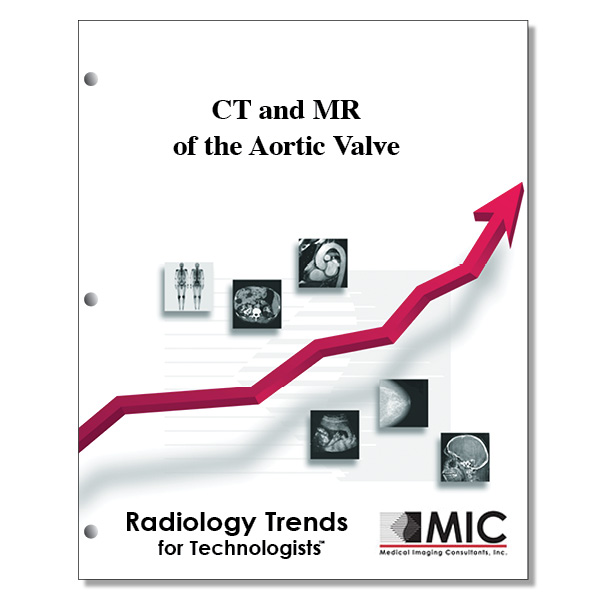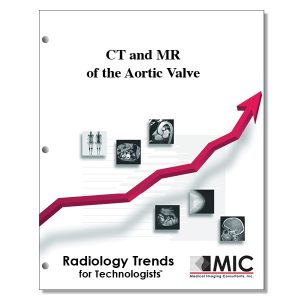

CT and MR of the Aortic Valve
Imaging techniques and abnormalities of the aortic valve are presented.
Course ID: Q00371 Category: Radiology Trends for Technologists Modalities: CT, MRI4.75 |
Satisfaction Guarantee |
$39.00
- Targeted CE
- Outline
- Objectives
Targeted CE per ARRT’s Discipline, Category, and Subcategory classification:
[Note: Discipline-specific Targeted CE credits may be less than the total Category A credits approved for this course.]
Cardiac-Interventional Radiography: 3.75
Procedures: 3.75
Diagnostic and Conduction System Studies: 1.75
Hemodynamics, Calculations, and Percutaneous Intervention: 2.00
Computed Tomography: 3.75
Procedures: 3.75
Neck and Chest: 3.75
Registered Radiologist Assistant: 3.75
Procedures: 3.75
Thoracic Section: 3.75
Outline
- Introduction
- Imaging Techniques
- Cardiac CT
- MR Imaging
- Quantitative Techniques
- Measurement of Calcification
- Planimetry
- Assessment of Ventricular Volume and Mass
- Two-dimensional Phse-Contrast MR Imaging
- Four-dimensional Phase-Contrast MR Imaging
- Normal Anatomy of the Aortic Valve
- Congenital Abnormalities of the Aortic Valve
- Aortic Stenosis
- Aortic Regurgitation
- Vegetations and Masses
- Bacterial Endocarditis
- Papillary Fibroelastomas
- Conclusions
Objectives
Upon completion of this course, students will:
- know the third most prevalent form of cardiovascular disease in the United States
- know which two heart valves are most often affected by rheumatic fever
- name the substance deposited in valve leaflets that results in degenerative valvular heart disease
- know which patient conditions may limit evaluation of the aortic valve by transthoracic echocardiography
- be familiar with the range of pixel sizes in CT imaging of the aortic valve
- know the tube voltage commonly used for CT of the aortic valve
- define pitch
- understand how beta-blockers may be used in CT of the heart and aortic valve
- be able to name a CT examination of the aorta or aortic valve that does not use contrast media
- know the 5 standardized ultrasound transducer positions for heart and valve evaluation
- understand the advantages and disadvantages of parallel imaging in MR
- be familiar with an en face view of the aortic valve
- know what a flow jet looks like on cine-MR images
- understand how delayed contrast-enhanced MR images can provide prognostic information in the setting of aortic stenosis
- know how valvular calcification is expressed
- know if MR can be used to quantify valvular calcification
- be familiar with planimetry and the images used to obtain the measurement
- know what principle the continuity equation is based on
- understand which parameters are associated with a poor outcome in asymptomatic patients with aortic stenosis
- know how to calculate ejection fraction
- know when papillary muscles and endocardial trabeculae are included in calculation of ventricular mass
- understand the relationship between left and right ventricular stroke volumes
- be familiar with calculation of blood flow velocity
- know the phase shift associated with maximum velocity at a given VENC
- be able to recognize aliasing in velocity encoded images
- know what mean pressure gradient classifies aortic stenosis as severe
- understand which congenital conditions may be diagnosed with the Qp/Qs ratio
- know where measurements are commonly made for evaluation of the aortic root
- identify the nodule on the closing edge of the aortic valve cusps
- know the approximate number of cardiac cycles per year
- know which heart valve is completely supported by a muscular outflow tract
- know the amount of backpressure in the aorta during diastole
- be familiar with recommended intervention timing for an asymptomatic aortic aneurysm in patients with a bicuspid aortic valve versus the general population
- know which cusps are most commonly fused in bicuspid aortic valves
- list possible causes of acquired sinus of Valsalva aneurysms
- know what substance is responsible for ventricular dysfunction in cases of myocardial fibrosis
- state the average survival time of symptomatic patients with aortic stenosis who do not have valve replacement
- be familiar with a common term for severe aortic calcification
- list treatment options for a stenotic aortic valve
- know causes of aortic valve regurgitation that impair valve leaflet function
- describe factors that may limit sensitivity of CT to demonstrate the regurgitant orifice
- know some conditions that may increase incidence of bacterial endocarditis
- understand why valvular bacterial endocarditis may be difficult to treat
- know the size of valvular vegetative lesion that can be reliably identified with CT
- know the decades of peak occurrence of papillary fibroelastoma
